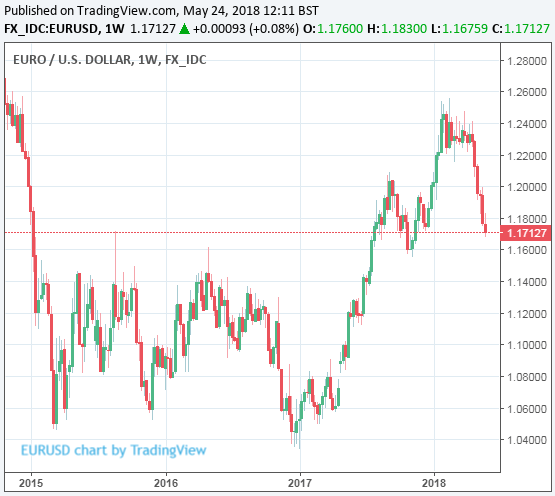EUR/USD Climbs as Dollar Weakens but Path Ahead is Clouded by New White House Trade Measures
- Written by: James Skinner
-Dovish FOMC aids EUR/USD higher on Thursday but outlook is murky.
-New White House trade actions cast longer shadow over single currency.
-EUR economic momentum fading fast, casting doubt over ECB tapering.

© Grecaud Paul, Adobe Stock
The Euro-to-Dollar rate rose Thursday as traders responded to a "dovish" set of Federal Reserve meeting minutes by dumping the US Dollar but the path ahead for the exchange rate is now increasingly muddied by the mounting prospect of a renewed protectionist bent in White House trade policy.
President Trump instructed commerce secretary Wilbur Ross to open an investigation into automotive imports, under Section 232 of the Trade Expansion Act of 1962, on Wednesday which has prompted fears the US might soon open a Europe-facing front in the so called trade war.
"Recall that this was the same process that the US administration took before imposing tariffs on steel and aluminium imports in March this year – and while we may still be some way away from the idea of actual tariffs on US car imports (with initial reports floating a 25% tariff), this latest move by the administration is a pretty big escalation in the trade war narrative," says Viraj Patel, an FX strategist at ING Group.
The section 232 investigation will seek to establish whether the current automotive trade landscape is a risk to US "national security" and could ultimately lead to the US imposing tariffs on imported cars and parts in an effort to protect domestic producers from foreign competition.
It comes after close to three months of rising tensions between the US and China which, seeing each announce a number of new tariffs against the other, prompted fears of a so called trade war between the world's two largest economies.
Any automotive trade action could become problematic for the Eurozone economy and Euro because the US is the largest export market for Europe's car industry, which supports hundreds of thousands of jobs across the continent - particularly in Germany and France.
However, many of these firms sell cars into the US from manufacturing bases in Mexico, which is trade that is facilitated by the North American Free Trade Agreement, and it is not clear to what extent NAFTA countries will be impacted by any tariffs. NAFTA is currently being renegotiated with a view to, among other things, forcing automotive production back into the US.
Nonetheless, for the Dollar at least, there will be implications and this could have a knock-on effect on the EUR/USD rate.

Above: Euro-to-Dollar rate shown at daily intervals.
"Recent history has shown that the impact of US protectionist policies on FX markets has been fairly ambiguous – but we note that speculation tends to be USD negative as the currency prices in some notion of a protectionist risk premium. The knee-jerk move lower in USD/JPY lends support to this view," says Patel.
The Dollar's likely short-term responses to the ebb and flow of White House trade rhetoric is a question that has divided analysts over recent months, with some saying protectionist measures should weaken the Dollar while others suggest it should augur a stronger greenback.
For what it's worth, the Dollar index rose notably in late March when the White House announced the first round of trade tariffs aimed at China, only to reverse course and fall around a week later when China responded in kind. The response from EUR/USD was decisively negative, with the exchange rate falling in both instances.

Above: USD index. Captures March bottom as well as April and May rally.
Europe's single currency has reversed an earlier 4% 2018 gain over the Dollar during the last eight weeks and now trades at a 2% loss for the year-to-date after data showed a persistent deterioration in Eurozone economic momentum during recent months and the US Dollar drew a new lease of life from rising bond yields that have boosted the relative attractiveness of US assets for investors.
Part of the Dollar's rebound has been driven by speculation the Federal Reserve may increase the pace at which it raises US interest rates over the coming quarters, although Wednesday's FOMC minutes put paid to this idea, which took some wind from the sails of bond yields and gave EUR/USD a breather Thursday. But strategist commentary on the single currency appears to suggest this nascent move may go only a limited distance at best.
"‘It just ain’t happening’ is probably the most apt phrase to sum up the prospects of a booming recovery in Eurozone growth this quarter after yesterday’s softer PMI readings and dip in consumer confidence. And there’s every temptation to extend this sentiment to the euro," Patel writes, in a briefing Thursday. "In the absence of EZ economic data finding another gear this side of summer, the chances of a hawkish ECB-led rally in the single currency look pretty bleak."
Markets have been anticipating the European Central Bank, heartened by a firming economic recovery on the continent, would announce an end date for it quantitative easing programme some time this summer, paving the way for an initial interest rate rise some time in 2019. This was the primary driver behind the single currency's 17% rally between early 2017 and 2018, as well as the basis for many an optimistic forecast for the 2018 and 2019 years.

Above: Euro-to-Dollar rate shown at weekly intervals.
Patel's comment about the exchange rate outlook is significant because the ING FX team have been persistently bullish in their forecasts for EUR/USD over the last year or so. ING's current forecast for EUR/USD at year-end is 1.30 although, having been issued at the end of 2017, it remains to be seen whether that forecast will survive the summer period if June and July fail to yield a European-Central-Bank-inspired rally.
Falling expectations for the Euro come amid a seemingly endless stream of deteriorating economic numbers from Europe. Just Thursday, German GDP growth was confirmed as having fallen from 0.6% to 0.3% during the first quarter and, on Wednesday, IHS Markit purchasing manager surveys showed activity in the key Eurozone manufacturing and services industries cooling even further during May.
"It was net trade which drove the slowdown. Both imports and exports fell sharply and net trade acted as a small drag on growth after making a significant positive contribution in Q4," says Jennifer McKeown, chief European economist at Capital Economics.
The Eurozone manufacturing index, arguably the most important for the single currency, came in at just 55.5 for the month and has now reversed all of its February to Decemeber 2017 gains. At 55.5, the May reading also represents a 50% reversal of the increase seen since the continental economy first began to show signs of picking up back in February 2016, when the index was at just 51.0.
"The business surveys have softened lately, implying that growth is very unlikely to regain last year’s pace. But while our previous 2018 forecast of 2.5% growth now looks a little optimistic, we still see the German economy expanding by 2% or a little more this year and next," McKeown adds.
Advertisement
Get up to 5% more foreign exchange by using a specialist provider to get closer to the real market rate and avoid the gaping spreads charged by your bank when providing currency. Learn more here.




